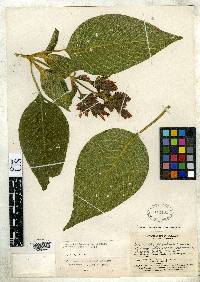
Neotropical Flora
|
Family: Acanthaceae
|
Slender erect, much-branched shrubs up to 6 meters high; stesm stout, obtusely quadrangular, broadly 4-sulcate, densely hirtellous or subtomentose, the hairs golden yellow, variously curved, up to 0.75 mm. long; leaf blades ovate or oblong-ovate, up to 25 cm. long and 12 cm. wide, acute to subacuminate (the tip itself obtuse), acute to obtuse at base, moderately firm, entire or undulate; the upper surface moderately to rather densely hirtellous, the hairs yellowish, septate, curved, up to 0.75 mm. long, the costa and lateral veins (14 or 15 pairs) prominent but less so than those of the lower surface, the cystoliths minute (about 0.2 mm. long) and obscure on both surfaces, the lower surface densely and softly subtomentose with golden yellow curved hairs up to 0.75 mm. long; petioles up to 8 cm. long, densely golden yellow tomentose or at least the channels so; panicles terminal sometimes with branches in the axils of the upper leaf blades, usually 10 to 20 cm. long and 6 to 8 cm. broad, more or less narrowed to tip; peduncles stout, these and the internodes of the inflorescence golden brown hirtellous or subtomentose, the lowermost nodes of the inflor- escence producing small leaf blades, the branches of the inflorescence ascending, bearing crowded more or less secund flowers and bracts; bracts subtending the flowers oblong-ovate, up to 12 mm. long and 5 mm. wide, acute or subacute, narrowed to 2 mm. at base, thin, subhyaline, usually pink, puberulous without (the hairs up to 175μ long), glabrous within, the costa and a pair of lateral nerves predom- inating; bractlets lanceolate, 8 mm. long, 2 mm. wide, subacute, in other respects similar to the bracts; calyx 8 to 12 mm. long, deeply segmented, the segments lanceolate, 1.5 to 2 mm. wide, acute, the inner surface glabrous, the outer puberulous with papilliform hairs, the costa and lateral nerves obscure; corolla pink or light red, mod- erately and finely pubescent except the glabrous basal portion (the hairs up to 128μ long, the pointed ones intermixed with a few stouter glandular ones), up to 35 mm. long, the tube 3 mm. broad at base, enlarged to 4 mm. and reduced to 3 mm. at 4 mm. above base, thence gradually enlarged to 4 or 5 mm. at mouth, the lips subequal, 12 to 15 mm. long, the upper lip erect, ovate, about 8 mm. wide at base, obtuse at tip, the lower lip strongly recurved, about 5 mm. wide near tip, 3-lobed, the lobes ovate, 3 to 5 mm. long, obtuse or rounded, the middle one 2 mm. wide, the lateral ones slightly narrower; stamens exserted, reaching tip of the upper lip of the corolla, the filaments flat, adnate to the corolla tube about 5 mm. below its mouth, glabrous or bearing a few minute hairs near base, the anther lobes slightly superposed, nearly parallel, 2 mm. long and 0.75 mm. broad, the lower cell ending in a blunt whitish tail about 0.5 mm. long and 0.25 mm. broad; pistil slightly shorter than the stamens, sparingly and minutely hirtellous; capsules clavate, 15 mm. long, 4 mm. broad, 3 mm. thick, finely hirtellous, the hairs about 125μ long, those at the tip spreading, the others retrorse; retinacula 2 mm. long, flat and truncate at tip; seeds suborbicular, flattened, about 2.5 mm. broad and long, strongly papillose. Type in the U. S. National Herbarium, No. 1352491, collected in a thicket between Suratá and California, Department of Santander, Colombia, 1,740 to 2,000 meters altitude, January 8-11, 1927, by E. P. Killip & Albert C. Smith (No. 16797). Isotypes: GH, NY. MAGDALENA: Forest near stream above Manaure, 800 meters altitude, Haught 3947 (US). Cincinati, Giacometto 80 (US). SANTANDER: Woods between El Roble and Toma, 1,500 to 1,900 meters, Killip & Smith 19391 (GH, NY, US). Thicket in the Río Suratá Valley, between El Jaboncillo and Suratá, 1,500 to 1,800 meters altitude, Killip & Smith 16462 (GH, NY, US). Justicia chrysocoma is closely related to J. rohrii, the inflorescences of the two species being quite similar in general appearance. Several striking differences exist, however. In J. chrysocoma, the leaf blades, especially on the lower surface, the petioles, stems, and internodes of the inflorescence are densely subtomentose with golden hairs, the bracts, bractlets, and calyces, as well as the internodes of the inflorescence, bear no patelliform hairs, and the corollas are pink or red. On the other hand, in J. rohrii the stems are minutely puber- ulous, the leaves are almost, if not entirely, glabrous, the bracts, bractlets, and calyces, as well as the internodes of the inflorescence, bear, in addition to the pointed hairs, some terminating in large patelliform glands, and the corollas are white or yellowish. There is also a marked difference in size. The plants of J. rohrii rarely exceed 2 meters in height, whereas those of J. chrysocoma may reach as much as 6 meters. The characters delineating J. chrysocoma are not so well marked in Haught's No. 3947. A fair percentage of the hairs of the inflores- cence is patelliform, and the tomentum is neither so dense nor of so golden a yellow as in typical specimens. Haught's plant seems to be intermediate between J. chrysocoma and J. rohrii. The specific epithet, chrysocoma, is from the Greek Xpvabкoμos, golden-haired. |
Powered by Symbiota.



